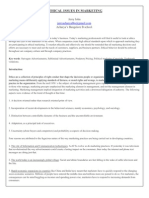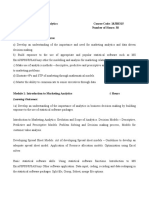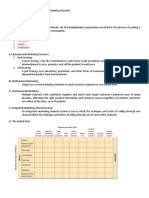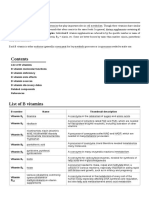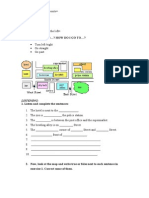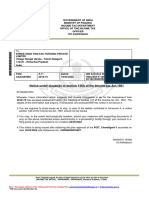Multi Channel Retailing Assignment
Multi Channel Retailing Assignment
Uploaded by
Charu SharmaCopyright:
Available Formats
Multi Channel Retailing Assignment
Multi Channel Retailing Assignment
Uploaded by
Charu SharmaCopyright
Available Formats
Share this document
Did you find this document useful?
Is this content inappropriate?
Copyright:
Available Formats
Multi Channel Retailing Assignment
Multi Channel Retailing Assignment
Uploaded by
Charu SharmaCopyright:
Available Formats
2013
Multi Channel Retailing
Submitted by:
Himanshu Bhatia Priyanka Sharma
2/10/2013
Multi Channel Retailing
Retailers traditionally maintained a single department, offering sales and support via a single mode of customer interaction like the physical store. Over time this has expanded to include multiple ways of selling to, engaging, and interacting with the customer, primarily via mail, catalogue and telephone. Advancing technology however, has led to a number of new ways of inter-personal interaction like the internet, mobile phones, and interactive TV; and as these embed deeper into social culture, subsequently new channels for offering product and service. Multi-Channel then refers to the delivery of customer propositions via multiple channels with at least some degree of cross channel integration in management, information and service, i.e. in a consistent and coordinated way across all channels. Complete integration and sharing of information and experience across all channels is now being referred to as Merged-Channel retailing, but that's a story for another paper. If you want to know more, have a look at my paper on The High Street 2.0, which is about merging online and offline customer experiences.
Drivers While emerging technology has been a key enabler, multi-channel growth is essentially driven by consumers. According to Shop.org, 34% of consumers today use at least three channels when shopping. Research has found them to spend up to 10 times more, to generate 25 to 50% more profit and demonstrate greater loyalty than their single-channel counterparts. The core driver then is customer demand. The other major driver is cost saving through efficiency and effectiveness. Managing channels separately may not only impair customer relationships but also result in cost increases resulting from running separate order-management and customer service operations, multiple warehouses and fulfillment systems, and buyers and merchandisers duplicating effort across the different channels. Multi-channel is also driven by strategic competitive advantage and differentiation opportunities, and regulatory pressures around ensuring that all customers are able to access products and services on offer. Benefits There are a huge number of both organizational and customer related benefits to be gained from implementing a multi-channel strategy. Heres a few:
Organizational Benefits Increased revenue and growth opportunities more touch points into target market Better responsiveness and sensitivity to changing environments Competitive advantage over pure-plays particularly around immediacy, education opportunities for complex products and easy e-merchandise returns. Organizational efficiency and effectiveness opportunities through sharing of processes, technology and information Customer Related benefits Better and wider customer interaction with a greater variety of information available for improved understanding of customers and identification of opportunities for increasing value per customer (business intelligence) Increased customer loyalty through better understanding of customers Better customer experience reducing churn and increasing loyalty Opportunity to leverage and improve brand perception Customers themselves also benefit from increased choice in interaction opportunities and the ability to switch channels as convenient Retail channel for interacting with customers Multi channel retailers are those retailers that sell merchandise or services through more than one channel by using combination of channels, retailers and can leverage the unique benefits provided by each to attract and satisfy more customers.
STORE CHANNEL:
Stores offer a number of benefits to customers that they cannot get when shopping through catalogs or on internets. Browsing: Browsing is a quick examination of the relevance of a number of objects which may or may not lead to a closer examination or acquisition/selection of (some of) these object. Many customers surf on net and look through catalogs or on the internet. Touching and feeling Products: Stores provides customer to the opportunity to use all five of their senses: Touching, Smelling, Tasting, Seeing and hearing while examining the product.
Personal Service: At the time customer enters the store he gets the chance by sales associates to provide more personalized information and advice during transaction and purchase. Cash Payment: Stores are the source which provides the direct cash payments as they do not prefer to pay interest generally. Entertainment and Social Experiences: In-store shopping can stimulate experiences for some people providing a break in their daily routine and enabling them to interact with personals. Immediate Gratification: Stores have the advantage of allowing customers to get the merchandise immediately after they buy it. Risk Reduction: When customer purchase merchandise in stores, the physical presence of the store assures them that any problem whit the process will be corrected.
CATALOG CHANNEL:
The catalog channel provides some benefits to customers that are not available from store or internet channels. The process of selling by looking at the images of the product in the form of book or a collection in a consolidated form is known as catalog buy. Convenience Safety Quality of Visual Presentation
INTERNET CHANNEL:
Shopping over the internet provides the connivance and safety benefits offered by catalogs and other non store formats. The Internet compared with store catalog channels, also has the potential to offer a greater selection of products and more personalized information. Broader selection More information to evaluate merchandize Personalization Selling merchandise with Touch and fell attributes Perceived risks in Electronic shopping
Evolution towards multichannel retailing
The inclination of customers from traditional store based and catalog retailers to multichannel retailers ends up with four reasons:
1) The electronic channel gives them an opportunity to overcome the limitations of
their primary existing format.
2) Using an electronic channel, retailers can reach out to new markets.
3) Providing a multichannel offering builds share of wallet or the percentage of
total purchases made by the customers from the retailer.
4) An electronic channel enables retailers to gain valuable insights into their
shopping behavior.
OVERCOMING LIMITATIONS OF AN EXISTING FORMAT: The size of store and maintenance cost with merchandise display constraints the customer and with the blend of online retail store it became way easy to them. The Online stores not only give benefits to sellers but also make the customer easy to buy, examine and pay.
EXPANDING MARKET PRESENCE: As per the modern era coming to its glory and increasing day by day the retailers became more advanced by becoming familiar with electronic devices and using online sources for reaching to their customers and creating new markets for themselves. The virtual shops are creating more profits with less human input physically and more mentally.
INCREASING SHARE OF WALLET: The attractive growth in the internet field made the influence on buying decision any day more than any other normal one. This not only makes the customer mind trapped with the offerings which grabs the large amount of investment over buying the offering on net and sometimes not even considering the need of the product.
INSIGHTS INTO CUSTOMER SHOPPING BEHAVIOR: The regular surfing of customer and association with online store capotes the data and buying habit insights into the system which enables the system of the particular sight a bit customized as per the customer need and preferences.
Capabilities needed for multi-Channel Retailing : Era change occurred due to boom in technology and introduction of Internet around the world. As previously all means of selling of goods and commodities were carried through catalogues or stores. So now for efficient & effective utilization of multichannel retailing benefits firms need to have following set of skills: Developing assortments & managing Inventory Employee Management (Distant location) Proper distribution of merchandise (End to End) Catalogues & websites E- Order Processing Efficient Home distribution channel Information Integration (Supporting Seamless Customer Experience) Who has these Critical resources?? Catalogue Retailers (Traditional Retailers) Store based retailers(Traditional Retailers) Electronic Retailers (Entrepreneurs) Do Manufacturers use the e- channel to sell their products: Yes it happens sometimes but due to this disintermediation (bypassing the retailer) they lack in various critical skills which are required to sell the merchandise electronically also they lack in variety of products and experience in terms of customer handling and due to the bypassing they lose the support of those retailers as well. Which channel is the most profitable? Catalogue & store channels are more profitable as the merchandise returns can be as high as 40 % for sales made through e-channels as compared to 6% of return s through Stores & catalogue channels.
Issues in multichannel retailing: Customers Need of getting Recognition Integration of Customer databases Brand image Merchandise assortment Pricing Integrated Shopping experience: By providing various features & services to customers: 1) Liberal Store policies(Purchase & return) 2) Online ordering & store pickups 3) Coupons & discounts on website 4) Free shipping of products 5) Cash on delivery/store 6) Website features retailers promotion & sales But all the above experiences are not applicable everywhere due to: => the legacy systems installed at their places => some with a very large array of inventory => budget constraint for applying high end technology E:g Snap Deal/Flipkart/Zovi (Online Ordering)
BATA TTK Prestige ( Exchange Anything for Anything)
Brand Image: Evenness in Product image projection like: => Taste => Colour => Type => Service => Variety => Quality
E:g => McDonalds
=> KFC
=> Big Bazaar (Iss se Sasta aur kahin nahi)
=> BATA
Merchandise assortment:
Integration of Merchandise offering across channels by determining assortment: => Firms retail strategy => Physical Characteristics of the store => Degree of Complementing of merchandise to each other.
E:g => Big Bazaar
=> Reliance trends/Fresh/ Digital
KFC McDonalds
Pricing: => Expected Pricing consistency => Pricing Strategy (a/c to competition) >>low prices/self-selected variable pricing >> Odd Pricing/Leader Pricing => Differential Pricing (a/c to local competition) =>(Customers)Transaction History to be recognised by retailers E:g Snap Deal/Flipkart (Online Ordering) BATA
TTK Prestige ( Exchange Anything for Anything)
Big Bazaar (Sabstey sastey paanch Din/ Maha Bachat Shop)
Shopping in the Future
Shopping experience: Consider retailing a two-pronged challenge: On the one hand, retailers must accommodate the increasingly mobile consumer. On the other hand, the traditional retailer can't ignore the need to drive that consumer to a physical store. In fact, many retailers are beginning to realize that rather than close stores, they can sustain them by giving them a much-needed facelift. More than a surface makeover, however, reinventing the store involves a thorough rework that often includes a growing trend: creating a "brand story" to engage and involve a consumer in the shopping experience.
Not surprisingly, this trend may bring with it interactive, intuitive and futuristic elements, such as virtual shopping screens, audio/video presentations, QR code integration and even robotic store displays.
5 Things That Will Shape the Future of shopping experience are:
1) Stores will no longer need lots of stock
While that may sound absurd at first, as we move forward on-site stock wont become an issue as many people will be arriving in store to pick up an online ordered product. In fact, the numbers who are shopping in-store will be reduced as customers arrive to look and test or try on the physical items before ordering them to their home address via their mobiles or in-store ordering terminals. Its not a farfetched idea either as 92 per cent of UK residents own a mobile phone, and 96 per cent of shoppers admit to researching a product on their mobile before making a purchase. Whats interesting is that, according to Webloyalty figures from 2012, 92 per cent of shoppers say they still use physical stores meaning that a future where a store is little more than a showroom and pick-up centre isnt that absurd to believe. If a customer does come in for a browse and finds that an item isnt available, or that the range on offer seems small, a handy augmented reality application could provide an insight into everything available online along with the various colours and fits available to be ordered in and picked up.
2) Stores will become education and experience centers
In the future although its already beginning to happen now with Asian Paints Colour Stores and Bonobos Guideshops stores will become places to educate customers into making the right purchase, which will be made elsewhere. Of course, this begs the question as to why a customer doesnt just go to another store to snap up the same product but cheaper. Experience stores would make the entire process effortless for a customer, therefore leading them to purchase from a company with ease. Both Bonobos and Asian Paints create an online basket or an RFID tag that means when you go to their online store, or another outlet, you can find exactly what you were guided through. It means the barrier for a customer to search and reorganize their basket is reduced most will just purchase them because it works out as the easier option. These stores also provide an experience for the consumer, meaning theyll come back again and again to get the knowledge they need to make the right choice. It essentially produces customer loyalty.
3) Retail shopping will become 24/7
Its already the case when it comes to online retail, but soon itll be present in the physical stores as customers want to be able to make purchases all day, every day preferably with shorter waiting periods for their item to be delivered. This is already creeping in with Adidas Germanys innovative window shopping store, or the German grocery store Emmas Enkel both of which allows users to make purchases in-store while the outlets are closed via those infuriating QR codes and touch screen interfaces. Moving to the more extreme applications, Augmented Reality allows online-only stores like Chinas Yihaodian to create always open stores inside physical environments while users shop with their augmented reality applications.
4) Shopping will become far more personal
Online stores already try this with their Hello xxxxx at the top of a page when youve logged in along with a list of items they think might be relevant, or of interest to you based on shopping history. But this is all entirely basic and analytics based Online stores can implement a more personal approach already by drawing up items gathered from purchases in other stores online via a unified payment account such as PayPal. From here a better picture of what a customer has purchased can be drawn up and therefore better offers can be given to an individual. This could also be done in store with a loyalty card capturing previous shopping history. A scanner by the door could log a customer into the shop especially if it utilized some sort of RFID tag or NFC technology and a staff member with a tablet would be able to identify them and see their previous shopping history. Naturally, this would allow them to provide a better level of customer service and personalization to the shopping experience rather like shopping used to be.
5) Shopping will be far more social
Social media is growing fast and companies are still trying to jump aboard and utilize each channel effectively. Those who are on Twitter wont want the same experience as those on Facebook, Vine or even Google +. This means that targeting a campaign or encouraging customers to shop with you could be a minefield as Disney discovered in a Facebook campaign. But why not let your customers do the social networking for you? After all, theyre the ones who know what platforms reach their friends and followers best. Theyre the ones who know who to target and whos interested. Its also a lot cheaper to run and manage and easier to handle damage control and sort problems out when things to awry. Already, some stores are doing this, with Quicksilver in South Africa running a Spaaza My Price promotion. Here, customers are given a discount based upon their Klout score. The higher your Klout, the bigger the discount and further discounts can be gained through Tweeting and sharing the news of your purchase. It also works like a loyalty card, racking up points each time you visit.
Indian retailscape Indian retail has evolved into a major growth opportunity. Retailing Industry in India is estimated at INR 15.5 trillion growing at CAGR of 15 to 20 % Organized Retail accounts for 5-8% which is lowest compared to its peers in BRIC countries Brazil (38%), Russia (33%) and China (20%) The Organized Retail has been growing at 35% CAGR. The retail and wholesale sector in India accounts for approx 14% of GDP In terms of employment, the sector is second largest employer providing over 10% of all formal jobs. Supported by strong economic fundamentals. India has witnessed a robust growth rate of 9% p.a. from 2005 to 2008 and an impressive growth of 6.7% in 2009 despite the global downturn Government is committed to encourage inclusive growth 72.2% of Indias population resides in rural areas. High agriculture growth rate offers huge potential Households forming rich class have grown at CAGR of 35% during and that of Major consuming class have grown at a CAGR of 11 %
The Indian retail market
Indian market has high complexities in terms of a wide geographic spread and distinct consumer preferences varying by each region necessitating a need for localization even within the geographic zones. India has highest number of outlets per person (7 per thousand) Indian retail space per capita at 2 sq ft (0.19 m2)/ person is lowest in the world Indian retail density of 6 percent is highest in the world. 1.8 million Households in India have an annual income of over 45 lakh (US$68,850.00). While India presents a large market opportunity given the number and increasing purchasing power of consumers, there are significant challenges as well given that over 90% of trade is conducted through independent local stores. Challenges include: Geographically dispersed population, small ticket sizes, complex distribution network, and little use of IT systems, limitations of mass media and existence of counterfeit goods. A number of merger and acquisitions have begun in Indian retail market. PWC estimates the multi-brand retail market to grow to $220 billion by 2020.
Challenges A McKinsey study claims retail productivity in India is very low compared to international peer measures. For example, the labor productivity in Indian retail was just 6% of the labor productivity in United States in 2010. India's labor productivity in food retailing is about 5% compared to Brazil's 14%; while India's labor productivity in non-food retailing is about 8% compared to Poland's 25%. Total retail employment in India, both organized and unorganized, account for about 6% of Indian labor work force currently - most of which is unorganized. This about a third of levels in United States and Europe; and about half of levels in other emerging economies. A complete expansion of retail sector to levels and productivity similar to other emerging economies and developed economies such as the United States would create over 50 million jobs in India. Training and development of labor and management for higher retail productivity is expected to be a challenge. In November 2011, the Indian government announced relaxation of some rules and the opening of retail market to competition.
India retail reforms Until 2011, Indian central government denied foreign direct investment (FDI) in multi-brand Indian retail, forbidding foreign groups from any ownership in supermarkets, convenience stores or any retail outlets, to sell multiple products from different brands directly to Indian consumers.. The government of Manmohan Singh, prime minister, announced on 24 November 2011 the following:
India will allow foreign groups to own up to 51 per cent in "multi-brand retailers", as supermarkets are known in India, in the most radical proliberalisation reform passed by an Indian cabinet in years; Single brand retailers, such as Apple and Ikea, can own 100 percent of their Indian stores, up from the previous cap of 51 percent; Both multi-brand and single brand stores in India will have to source nearly a third of their goods from small and medium-sized Indian suppliers; All multi-brand and single brand stores in India must confine their operations to 53-odd cities with a population over one million, out of some 7935 towns and cities in India. It is expected that these stores will now have full access to over 200 million urban consumers in India; Multi-brand retailers must have a minimum investment of US$100 million with at least half of the amount invested in back end infrastructure, including cold chains, refrigeration, transportation, packing, sorting and processing to considerably reduce the post harvest losses and bring remunerative prices to farmers; The opening of retail competition will be within India's federal structure of government. In other words, the policy is an enabling legal framework for India. The states of India have the prerogative to accept it and implement it, or they can decide to not implement it if they so choose. Actual implementation of policy will be within the parameters of state laws and regulations.
The opening of retail industry to global competition is expected to spur a retail rush to India. It has the potential to transform not only the retailing landscape but also the nation's ailing infrastructure.,
SUMMARY
Closing thoughts: Be dynamic, maintain focus
Multichannel retail: More than clicks and bricks making use of multiple channels create significant opportunities for retailers to grow revenues and better target and interact with customers. At the same time, company leadership must understand and manage a host of challenges and risks, many of which pertain to operations, data security, fraud prevention and taxes. Retailers that survive and prosper must be dynamic enough to adapt to evolving multichannel demands and focused enough to deal with the attendant issues. While the multichannel landscape is always changing, the path ahead is clear. Retail channels will continue to widen, offering customers more autonomy over their shopping practices. In an uncertain economy, one of the safest bets for enhancing revenues may be providing consumers with a comprehensive and effective multichannel experience.
You might also like
- Understanding Architectural Details - Book 1: SampleDocument47 pagesUnderstanding Architectural Details - Book 1: SampleAhmed FaraedoonNo ratings yet
- Marketing Metrics - Chapter 4Document38 pagesMarketing Metrics - Chapter 4Hoang Yen NhiNo ratings yet
- 7 oDocument37 pages7 osramuspjimr100% (2)
- Branding AssignmentDocument7 pagesBranding Assignmentpritom sarkerNo ratings yet
- Ethical Issues in MarketingDocument4 pagesEthical Issues in MarketingJerry JohnNo ratings yet
- 9h The Flowers Annotation and Analysis ExerciseDocument2 pages9h The Flowers Annotation and Analysis Exerciseapi-263744910No ratings yet
- 1st Grade Houghton Mifflin Reading at A GlanceDocument3 pages1st Grade Houghton Mifflin Reading at A GlanceBembem DuavesNo ratings yet
- Credit Card Statement: Gerson ChirinosDocument2 pagesCredit Card Statement: Gerson ChirinosArgenis Del Jesus VillalbaNo ratings yet
- Multichannel Retailing.-Mftech - Final PPT - PpsDocument64 pagesMultichannel Retailing.-Mftech - Final PPT - PpsDivyanshJainNo ratings yet
- Fundamentals of Marketing - IntroductionDocument30 pagesFundamentals of Marketing - Introductionjrvillz11No ratings yet
- Role of AI in RetailDocument46 pagesRole of AI in RetailpavanNo ratings yet
- Power Point Presentation On Pricing Strategy and Brand ManagementDocument34 pagesPower Point Presentation On Pricing Strategy and Brand Managementlegese lemmaNo ratings yet
- Management of Sales Territories and QuotasDocument7 pagesManagement of Sales Territories and QuotasRavimohan RajmohanNo ratings yet
- B2B Brand ArchitectureDocument2 pagesB2B Brand ArchitectureVenkataramanan VaidyanathanNo ratings yet
- Line & Brand ExtensionsDocument40 pagesLine & Brand ExtensionsAshish Khewariya100% (1)
- Sales and Distribution ManagementDocument21 pagesSales and Distribution Managementshubhro gomesNo ratings yet
- Pepper FryDocument17 pagesPepper FryAditi GoenkaNo ratings yet
- Marketing in The Age of AlexaDocument19 pagesMarketing in The Age of AlexaAl Norin AhmadNo ratings yet
- Range PlanningDocument43 pagesRange PlanningGarvit GargNo ratings yet
- Semester: 3 Course Name: Marketing Analytics Course Code: 18JBS315 Number of Credits: 3 Number of Hours: 30Document4 pagesSemester: 3 Course Name: Marketing Analytics Course Code: 18JBS315 Number of Credits: 3 Number of Hours: 30Lipson ThomasNo ratings yet
- Customer Relationship Management: Hindustan Unilever LimitedDocument5 pagesCustomer Relationship Management: Hindustan Unilever LimitednishitsardharaNo ratings yet
- Customer Relationship Management A Databased Approach: V. Kumar Werner J. ReinartzDocument42 pagesCustomer Relationship Management A Databased Approach: V. Kumar Werner J. ReinartzApoorwa MishraNo ratings yet
- BossardDocument19 pagesBossardमंगेश पाटील100% (1)
- Assignment: Amazon Case StudyDocument2 pagesAssignment: Amazon Case StudyAhsan BaigNo ratings yet
- Retail StrategyDocument56 pagesRetail StrategyPriyanko DasguptaNo ratings yet
- Strategic Marketing Unit 1Document13 pagesStrategic Marketing Unit 1Rishabh GangwarNo ratings yet
- Final Presentation - ITC LTD in Sales and DistributionDocument19 pagesFinal Presentation - ITC LTD in Sales and Distributionabhi_43210% (1)
- Shoppers Stop B2B ProjectDocument13 pagesShoppers Stop B2B ProjectSrishti Singh100% (1)
- What Is Aggregate PlanningDocument22 pagesWhat Is Aggregate PlanningVamsi krishnaNo ratings yet
- ProductDocument71 pagesProductYoseph GesseseNo ratings yet
- Aswin 80303180002Document12 pagesAswin 80303180002Shambhawi Sinha100% (1)
- Unique Pricing Strategies of FlipkartDocument3 pagesUnique Pricing Strategies of Flipkartpari shuklaNo ratings yet
- Note On Marketing FrameworksDocument7 pagesNote On Marketing FrameworksdarrenNo ratings yet
- BM - PPT 1Document71 pagesBM - PPT 1Sanjoli Jain100% (1)
- Chapter 1 - Tapan Panda Sales and Distribution ManagementDocument42 pagesChapter 1 - Tapan Panda Sales and Distribution ManagementDipyaman Choudhury100% (1)
- UNIT 4 - Distribution Channels PDFDocument15 pagesUNIT 4 - Distribution Channels PDFVijayGogulaNo ratings yet
- Customer Insights SummaryDocument30 pagesCustomer Insights SummaryAsya Orhan100% (1)
- Ansoff MatrixDocument25 pagesAnsoff Matrixrajisuma100% (1)
- 317 Marketing of High Technology ProductsDocument1 page317 Marketing of High Technology ProductsRaj PatilNo ratings yet
- Marketing Research in High Tech MarketsDocument82 pagesMarketing Research in High Tech MarketsHarshit MarwahNo ratings yet
- IIM Kashipur: PGP 2: Term 5: Digital Marketing: Prantoshb@iima - Ac.inDocument4 pagesIIM Kashipur: PGP 2: Term 5: Digital Marketing: Prantoshb@iima - Ac.inNikhil DixitNo ratings yet
- Brand Management Assignment 2Document54 pagesBrand Management Assignment 2SherazButtNo ratings yet
- Chapter02 - Customer-Based Brand Equity and Brand PositioningDocument36 pagesChapter02 - Customer-Based Brand Equity and Brand PositioningThảo PhươngNo ratings yet
- Types of RetailersDocument46 pagesTypes of RetailersDr. Neelam Shrivastava (SAP Professor)0% (1)
- Chapter 5 Retail Market Segmentation-Retail ManagementDocument18 pagesChapter 5 Retail Market Segmentation-Retail ManagementCommunity Institute of Management StudiesNo ratings yet
- Designing and Managing Integrated Marketing ChannelsDocument8 pagesDesigning and Managing Integrated Marketing ChannelsGERALD ANGELO BUDUAN100% (1)
- Selling Today Manning Reece Ahearne - Chapter 5Document17 pagesSelling Today Manning Reece Ahearne - Chapter 5Free Course100% (1)
- RM Pepperfry Group 3Document5 pagesRM Pepperfry Group 3Mayank RanjanNo ratings yet
- Adidas Growth StrategiesDocument5 pagesAdidas Growth StrategiesbigbosssongnguNo ratings yet
- E-Commerce & Retail Management: Project byDocument19 pagesE-Commerce & Retail Management: Project byVivek Kashyap100% (1)
- Consumer Behaviour Towards E-ServiceDocument29 pagesConsumer Behaviour Towards E-ServiceAnkita ShettyNo ratings yet
- Sr. No. Topic Page Number: IndexDocument53 pagesSr. No. Topic Page Number: IndexArman Shaikh100% (1)
- Grocery Retail Market Inquiry SumaryDocument20 pagesGrocery Retail Market Inquiry SumaryKatlego MaileNo ratings yet
- Marketing Domain QuestionsDocument7 pagesMarketing Domain QuestionsdebasishroutNo ratings yet
- MARKET SEGMENTATION, TARGETING & POSITIONING - by Arihant Aski GoswamiDocument26 pagesMARKET SEGMENTATION, TARGETING & POSITIONING - by Arihant Aski GoswamiArihant Aski Goswami93% (15)
- The Impact of Digital Marketing Channels On Consumer Buying DecisionDocument12 pagesThe Impact of Digital Marketing Channels On Consumer Buying DecisionVicneswaran SegarNo ratings yet
- Imc PlanningDocument19 pagesImc PlanningAshish Agnihotri100% (1)
- Know Online Advertising: All Information About Online Advertising at One PlaceFrom EverandKnow Online Advertising: All Information About Online Advertising at One PlaceNo ratings yet
- Mobile Banking and Internet BankingDocument10 pagesMobile Banking and Internet BankingNeeraj DwivediNo ratings yet
- B VitaminsDocument10 pagesB Vitaminsahmad aliNo ratings yet
- TleDocument5 pagesTleJeferson0% (1)
- WHERE Is Giving DirectionsDocument1 pageWHERE Is Giving DirectionsAina19191No ratings yet
- Kubota Tractor M105S PM 04780Document478 pagesKubota Tractor M105S PM 04780ElcoteamNo ratings yet
- Creating RAIN EFFECT With ACTIONSCRIPTDocument9 pagesCreating RAIN EFFECT With ACTIONSCRIPTRuby BartNo ratings yet
- Saum (Fasting) Class LectureDocument8 pagesSaum (Fasting) Class LecturePaper CutNo ratings yet
- Corporate Social Responsibility-Charity or Gimmick (New)Document4 pagesCorporate Social Responsibility-Charity or Gimmick (New)286DEVESH MISHRANo ratings yet
- Tecnoglass Invests New Glaston Machinery To Stay AheadDocument1 pageTecnoglass Invests New Glaston Machinery To Stay AheadChristian Daes100% (1)
- Electrical Circuits (EEE/ETE-141)Document20 pagesElectrical Circuits (EEE/ETE-141)Little WizardNo ratings yet
- Midterm Written Assignment - Thiago AndreDocument5 pagesMidterm Written Assignment - Thiago AndreThiago AndréNo ratings yet
- Alfandi and Alkahsawneh - 2014 - The Role of The Incentives and Reward System in Enhancing Employee's Performance PDFDocument16 pagesAlfandi and Alkahsawneh - 2014 - The Role of The Incentives and Reward System in Enhancing Employee's Performance PDFAnonymous FFD8NMVYyNo ratings yet
- BRU Café Design BriefDocument5 pagesBRU Café Design BriefPriyanka Ganguly100% (2)
- Game Theory: Guillem RoigDocument28 pagesGame Theory: Guillem RoigJ. Fernando G. R.No ratings yet
- Basics of HydraulicsDocument13 pagesBasics of HydraulicsJames DanielNo ratings yet
- 1st Quarterly Exam FABM 2Document5 pages1st Quarterly Exam FABM 2Mary Ann R. MoraNo ratings yet
- Reform and Revolution - Reactions To The Spanish Rule: Early Native UprisingDocument35 pagesReform and Revolution - Reactions To The Spanish Rule: Early Native UprisingKleiNo ratings yet
- Physical Education: Quarter 1 - Module 4: Introduction To Individual Sports: Rhythmic GymnasticsDocument24 pagesPhysical Education: Quarter 1 - Module 4: Introduction To Individual Sports: Rhythmic Gymnasticsjustine alina100% (1)
- CCN PPT CourseDocument264 pagesCCN PPT Coursepankaj rangareeNo ratings yet
- SsvfplAAICS8788C - Show Cause Notice For Proceedings Us 148A - 1041050229 (1) - 19032022Document2 pagesSsvfplAAICS8788C - Show Cause Notice For Proceedings Us 148A - 1041050229 (1) - 19032022Babbar & Co BabbarNo ratings yet
- SCM Unit 5Document24 pagesSCM Unit 5AMAN VERMANo ratings yet
- Trabajo Semana 45 PH03Document195 pagesTrabajo Semana 45 PH03Derlis Diego Yaringaño PerezNo ratings yet
- Module 3Document9 pagesModule 3Jay BaliarNo ratings yet
- LAW 102-Introduction To Pakistan Legal System-Marva KhanDocument6 pagesLAW 102-Introduction To Pakistan Legal System-Marva Khanfarah khanNo ratings yet
- PDF Quotations 1596737373390Document1 pagePDF Quotations 1596737373390Shashank KumarNo ratings yet
- Barriers To CommunicationDocument16 pagesBarriers To Communicationrooroli74No ratings yet




